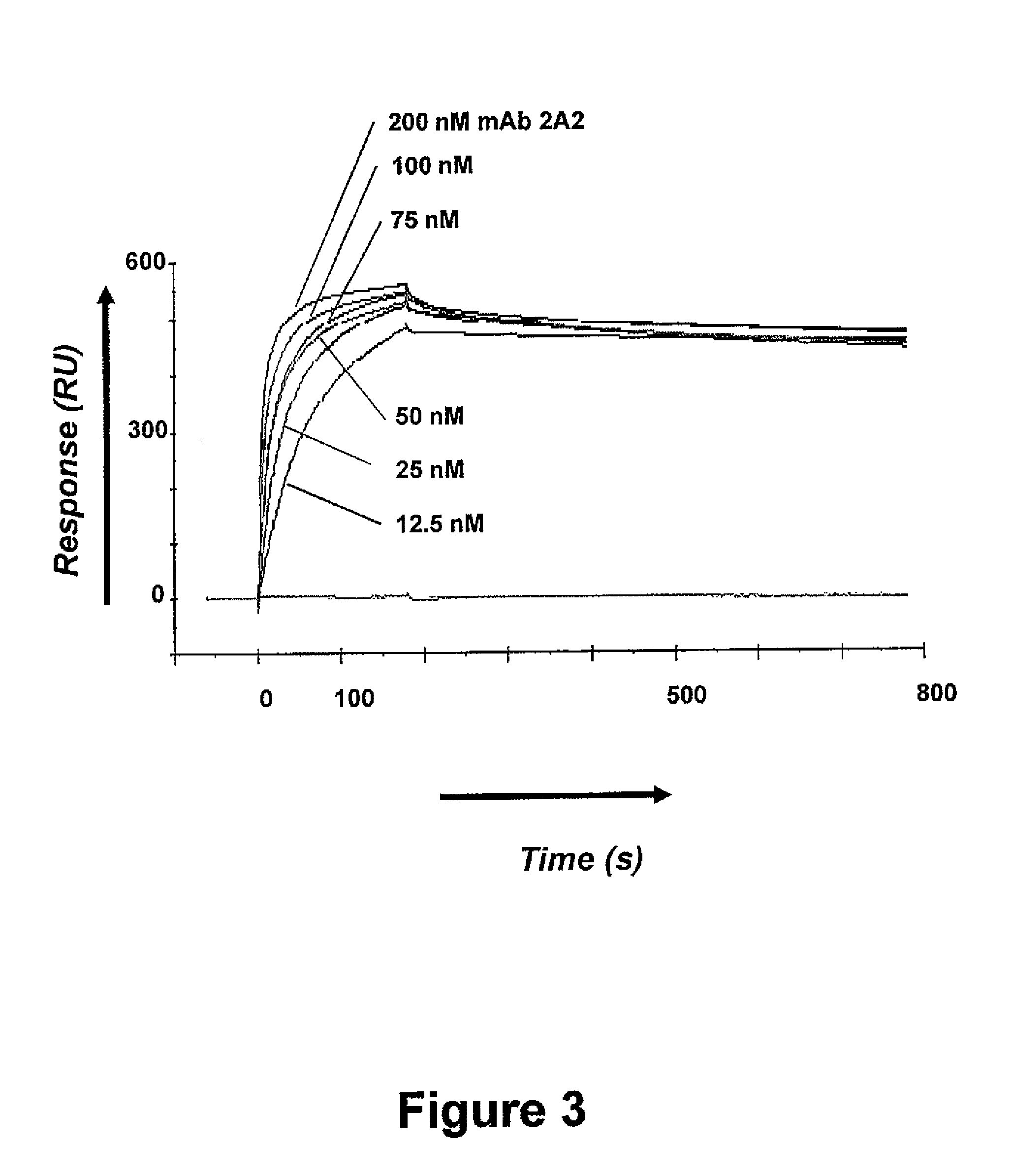Anti-human ROR1 antibodies
a technology of human ror1 and antibodies, applied in the field of antihuman ror1 antibodies, can solve the problems of no commercial therapeutic antibody, damage to healthy cells and tissues,
- Summary
- Abstract
- Description
- Claims
- Application Information
AI Technical Summary
Problems solved by technology
Method used
Image
Examples
example 1
[0066]This example demonstrates the preparation of monoclonal antibodies with specificity for ROR1.
[0067]Mice were immunized with a fusion protein consisting of the human Fc domain and extracellular domain of human ROR1 (Fc-ROR1). As depicted in FIG. 1, the extracellular domain of ROR1 includes an immunoglobulin (Ig) domain, a Frizzled domain, and a Kringle domain, which span about 393 amino acids of the amino-terminal portion of ROR1. A nucleic acid sequence encoding the ROR1 extracellular domain was recombinantly linked to a nucleic acid sequence encoding human Fc1 to form a recombinant construct that then was expressed in HEK 293 cells. The produced Fc-ROR1 fusion protein (depicted in FIG. 2B) was harvested and purified by ion exchange chromatography and gel filtration or by Protein A affinity chromatography. The results of a Coomassie-stained protein gel analysis of purified Fc-ROR1 under non-reducing and reducing conditions are shown in FIG. 2C.
[0068]Mice were immunized with th...
example 2
[0072]This example further demonstrates the desirable binding properties of mAb 2A2 for ROR1.
[0073]Hybridoma 2A2 of Example 1 was grown in CELLINE Disposable Bioreactors (BD Biosciences, San Jose, Calif.) using animal component-free BD Cell MAb Medium. Expressed mAb 2A2 was purified by Protein G affinity chromatography.
[0074]The avidity of mAb 2A2 for ROR1-ECD was determined using surface plasmon resonance in a BIACORE X100 instrument (GE Healthcare, Piscataway, N.J.). Human ROR1-ECD was coupled to a BIACORE CM5 chip at 1600 resonance units. MAb 2A2 was diluted in HBS-EP buffer (0.01 M HEPES, 0.15 M NaCl, 3 mM EDTA, and 0.005% surfactant P20, pH 7.4; GE Healthcare) to various concentrations (from about 200 nM to about 12.5 nM) and injected sequentially. As depicted by the extended, flat tail in FIG. 3, antibody binding was very stable at all concentrations tested. Association (k-on) and dissociation (k-off) rate constants were calculated based on a 1:1 Langmuir binding model using B...
example 3
[0078]This example demonstrates the identification of mAb 2A2 variable domain coding and amino acid sequences.
[0079]The variable domain encoding sequences of heavy (VH) and light (VL) chain of mAb 2A2 were RT-PCR amplified from hybridoma 2A2 total RNA using published primer sequences (Morrison, S. L., in Curent Protocols in Immunology, Suppl. 47, pp. 2.12.1-2.12.17, John Wiley and Sons, 2002). The cDNAs were cloned and analyzed by DNA sequencing. VH and VL chain sequences were independently confirmed by liquid chromatography-tandem mass spectrometry (LC-MS / MS) analysis of the tryptic digests of the heavy and light chain polypeptides, which were resolved by sodium dodecyl sulfate polyacrylamide gel electrophoresis (SDS-PAGE). The amino acid sequences and cDNA sequences of the VH and VL chains of mAb 2A2 are depicted in FIGS. 5 and 6 (“original sequences”), respectively.
PUM
| Property | Measurement | Unit |
|---|---|---|
| equilibrium dissociation constant | aaaaa | aaaaa |
| concentrations | aaaaa | aaaaa |
| concentrations | aaaaa | aaaaa |
Abstract
Description
Claims
Application Information
 Login to View More
Login to View More - R&D
- Intellectual Property
- Life Sciences
- Materials
- Tech Scout
- Unparalleled Data Quality
- Higher Quality Content
- 60% Fewer Hallucinations
Browse by: Latest US Patents, China's latest patents, Technical Efficacy Thesaurus, Application Domain, Technology Topic, Popular Technical Reports.
© 2025 PatSnap. All rights reserved.Legal|Privacy policy|Modern Slavery Act Transparency Statement|Sitemap|About US| Contact US: help@patsnap.com



